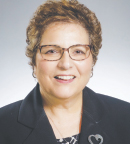In breast cancer survivors after lymph node dissection, a combined education and exercise intervention resulted in patients regaining full range of motion in both arms sooner than those who received education alone, according to follow-up from a phase III clinical trial reported by Electra D. Paskett, PhD, at the Cancer Survivorship Symposium in Orlando.1

All women receiving lymph node dissection should receive physical therapy to regain range of motion quickly after surgery and help maintain physical functioning.— Electra D. Paskett, PhD
Tweet this quote
The majority of women treated for breast cancer receive lymph node dissection, and both axillary and sentinel node dissections often result in temporary or permanent restrictions of arm movement, including range of motion.
“We hope this study brings awareness to the need to follow-up with women who have had lymph node surgery and experience range-of–arm motion problems as a result,” said Dr. Paskett, Professor of Cancer Research at The Ohio State University and Associate Director for Population Sciences at The Ohio State University Comprehensive Cancer Center–Arthur G. James Cancer Hospital and Richard J. Solove Research Institute in Columbus. “All women receiving lymph node dissection should receive physical therapy to regain range of motion quickly after surgery and help maintain physical functioning.”
About the Study
As part of the Lymphedema Education and Prevention (LEAP) clinical trial, researchers recruited women with stage I to III breast cancer from 38 participating sites who had received either a full axillary node or sentinel node dissection as part of breast cancer treatment. A total of 568 patients were randomly assigned to either the education-only group or the intervention group, which involved both education and exercise.
“Most women who have had lymph node dissection get an instruction sheet on exercise after they are discharged from surgery but little else,” said Dr. Paskett. “As a breast cancer survivor myself who experienced swelling after surgery, I thought it was important to try to determine whether women were receiving adequate follow-up to deal with certain health issues, including the loss of the range of motion in their arms.”
AVOIDING LYMPHEDEMA
- Compared to education alone, education and guided exercise helped women regain their range of arm motion more quickly after lymph node dissection.
- At 12 months postsurgery, women in the intervention arm were significantly more likely to report full range of motion compared to women who received education only.
- Analysis of the surgery arm alone revealed that patients in the intervention group were significantly more likely to report full range of motion in their affected arm at both 12 and 18 months postsurgery.
The education-only group received information related to causes, signs, symptoms, and risk-reduction strategies for lymphedema. In the exercise group, a one-time session with a lymphedema specialist included lymph flow, strengthening, and breathing exercises; distribution of an elastic compression sleeve or gauntlet and instructions about utilizing it; a take-home video demonstrating exercises; hand weights; and reinforcing educational materials.
Assessment of range of motion relied on self-reported data, collected using five categories, ranging from “very little” to “full,” and patients completed surveys and arm measurements at baseline and after 12 and 18 months. Two analyses were performed: One looked at range-of-motion differences between study groups before surgery and at 12 and 18 months postsurgery in both the right and left arms, whereas the other evaluated range of motion in the surgery-arm only. The second analysis was fully adjusted for baseline body mass index, type of surgery, type of lymph node dissection, affected arm being the dominant arm, and receipt of radiation therapy and/or chemotherapy.
Impact of Exercise
Before surgery, fewer women in the intervention group than in the education-only group reported full range of arm motion (left arm: 58% vs 75%; right arm: 57% vs 76%). But at 12 months postsurgery, women in the intervention group were significantly more likely to report full range of motion compared to women in the education-only arm (left arm: 91% vs 84%, right arm: 90% vs 83%). Though the women in the intervention group improved more quickly, at 18 months postsurgery, 93% of women in both groups reported having regained full range of motion in both arms.
In the affected arm only, patients in the education-plus-exercise cohort were significantly more likely to report full range of motion at 12 and 18 months. Women in the intervention arm had a 32% increase in full range of motion at 12 months compared to presurgery, as opposed to a 6% increase in full range of motion in the education-only arm. At 18 months, the increase in range of motion was 37% and 13% in the intervention and education arms, respectively.
“These results tell us that one visit to a physical therapist after surgery is important in these women being able to regain full range of motion quickly,” Dr. Paskett said. “This is related to physical functioning, which is important to overall mortality and quality of life.”
This study is cited in the recently updated National Comprehensive Cancer Network® (NCCN®) Survivorship Guidelines in the algorithm addressing lymphedema.2 ■
DISCLOSURE: Dr. Paskett is a multiple principal investigator on a study funded by the Merck Foundaion and is a stockholder in Pfizer.
REFERENCES
1. Paskett ED, et al: 2018 Cancer Survivorship Symposium. Abstract 123. Presented February 17, 2018.
2. NCCN Clinical Practice Guidelines in Oncology: Survivorship, version 3.2017, updated February 16, 2018. Available at www.nccn.org. Accessed April 2, 2018.


